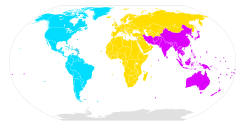3-centimeter band
The 3 centimeter or 10 GHz band is a portion of the SHF (microwave) radio spectrum internationally allocated to amateur radio and amateur satellite use on a secondary basis. The amateur radio band is between 10.00 GHz and 10.50 GHz, and the amateur satellite band is between 10.45 GHz and 10.50 GHz. The allocations are the same in all three ITU regions.[1]
List of notable frequencies

- 10.368.1 GHz Region 2 narrow band calling frequency[2][3]
- 10.368.2 GHz Region 1 narrow band calling frequency[4]
- 10.368.3 to 10.368.4 GHz Region 2 propagation beacons[2][3]
- 10.368.75 to 10.368.99 GHz Region 1 propagation beacons[4]
Wideband FM Channels
Common Wideband FM frequencies used with gunnplexers.
Operation is in full-duplex with a 30 or 90 MHz split:
- 10.220 GHz
- 10.250 GHz †
- 10.280 GHz †
- 10.310 GHz
- 10.340 GHz
- 10.370 GHz ‡
- 10.400 GHz
- 10.430 GHz
† Most commonly used frequency pair for gunnplexers in North America. (10.200 to 10.300 GHz is reserved for gunnplexers in the ARRL Band Plan.[3])
‡ Should only be used if interference is not caused to narrow-band stations.
See also
References
- ↑ "FCC Online Table of Frequency Allocations" (PDF). 47 C.F.R. Federal Communications Commission. August 13, 2015. Retrieved October 27, 2015.
- 1 2 "IARU Region 2 Band Plan" (PDF). International Amateur Radio Union Region 2. October 14, 2016. p. 13.
- 1 2 3 "Band Plan". American Radio Relay League. Retrieved February 18, 2015.
- 1 2 "VHF Managers Handbook" (PDF). 7. International Amateur Radio Union Region 1. January 2015. p. 50. Retrieved October 27, 2015.
| Range | Band | ITU Region 1 | ITU Region 2 | ITU Region 3 |
|---|---|---|---|---|
| LF | 2200 m | 135.7 kHz – 137.8 kHz | ||
| MF | 630 m | 472 kHz – 479 kHz | ||
| 160 m | 1.810 MHz – 1.850 MHz | 1.800 MHz – 2.000 MHz | ||
| HF | 80 / 75 m | 3.500 MHz – 3.800 MHz | 3.500 MHz – 4.000 MHz | 3.500 MHz – 3.900 MHz |
| 60 m | 5.3515 MHz – 5.3665 MHz | |||
| 40 m | 7.000 MHz – 7.200 MHz | 7.000 MHz – 7.300 MHz | 7.000 MHz – 7.200 MHz | |
| 30 m[w] | 10.100 MHz – 10.150 MHz | |||
| 20 m | 14.000 MHz – 14.350 MHz | |||
| 17 m[w] | 18.068 MHz – 18.168 MHz | |||
| 15 m | 21.000 MHz – 21.450 MHz | |||
| 12 m[w] | 24.890 MHz – 24.990 MHz | |||
| 10 m | 28.000 MHz – 29.700 MHz | |||
| VHF | 6 m | 50.000 MHz – 52.000 MHz[x] | 50.000 MHz – 54.000 MHz | |
| 4 m[x] | 70.000 MHz – 70.500 MHz | N/A | ||
| 2 m | 144.000 MHz – 146.000 MHz | 144.000 MHz – 148.000 MHz | ||
| 1.25 m | N/A | 220.000 MHz – 225.000 MHz | N/A | |
| UHF | 70 cm | 430.000 MHz – 440.000 MHz | 430.000 MHz – 440.000 MHz (420.000 MHz – 450.000 MHz)[y] | |
| 33 cm | N/A | 902.000 MHz – 928.000 MHz | N/A | |
| 23 cm | 1.240 GHz – 1.300 GHz | |||
| 13 cm | 2.300 GHz – 2.450 GHz | |||
| SHF | 9 cm | 3.400 GHz – 3.475 GHz[y] | 3.300 GHz – 3.500 GHz | |
| 5 cm | 5.650 GHz – 5.850 GHz | 5.650 GHz – 5.925 GHz | 5.650 GHz – 5.850 GHz | |
| 3 cm | 10.000 GHz – 10.500 GHz | |||
| 1.2 cm | 24.000 GHz – 24.250 GHz | |||
| EHF | 6 mm | 47.000 GHz – 47.200 GHz | ||
| 4 mm[y] | 75.500 GHz[x] – 81.500 GHz | 76.000 GHz – 81.500 GHz | ||
| 2.5 mm | 122.250 GHz – 123.000 GHz | |||
| 2 mm | 134.000 GHz – 141.000 GHz | |||
| 1 mm | 241.000 GHz – 250.000 GHz | |||
| THF | Sub-mm | Some administrations have authorized spectrum for amateur use in this region; others have declined to regulate frequencies above 300 GHz, leaving them available by default. | ||
|
[w] HF allocation created at the 1979 World Administrative Radio Conference. These are commonly called the "WARC bands". | ||||
| See also: Radio spectrum, Electromagnetic spectrum | ||||